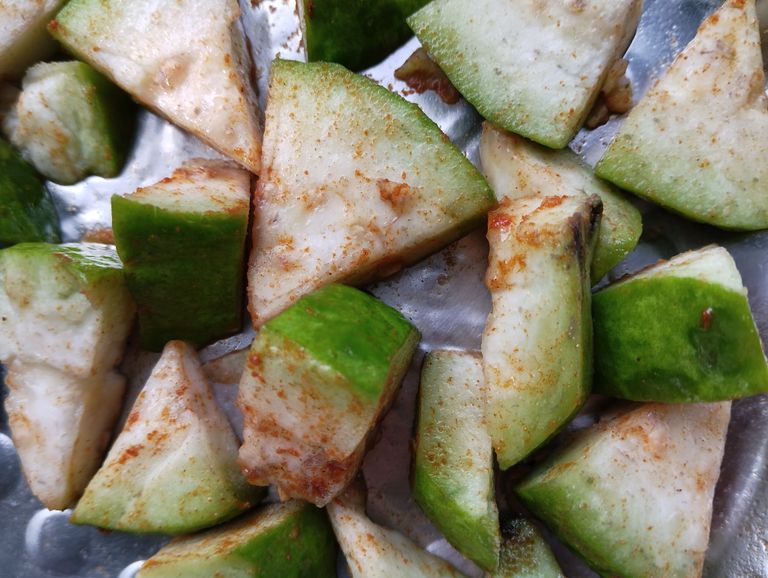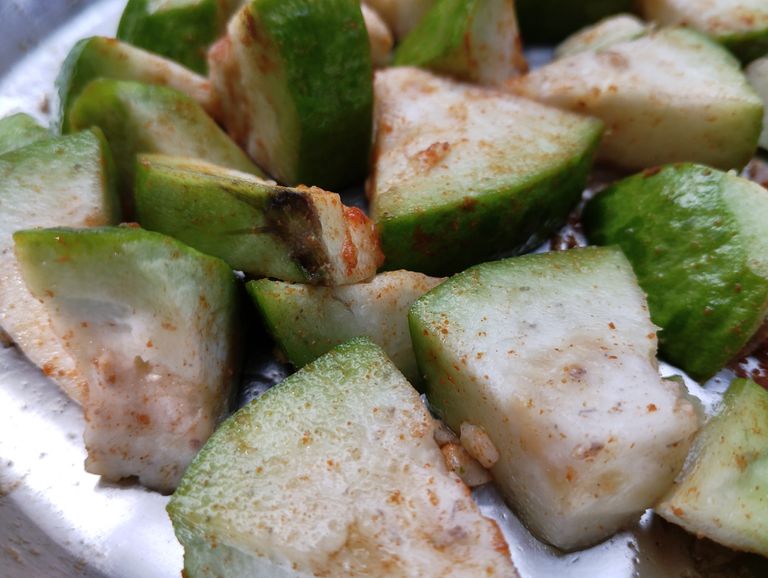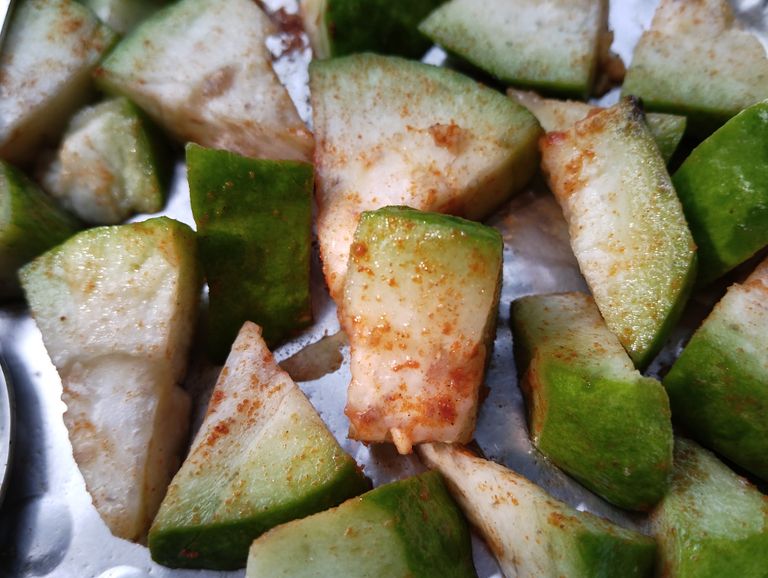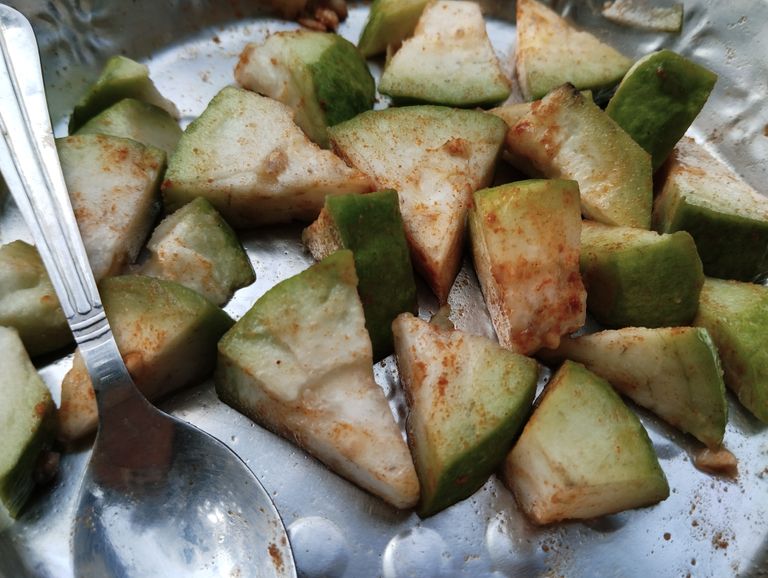
Sweet, Sour, and Spicy Guava Mix A Burst of Flavors.
Guava, a tropical fruit loved for its unique taste and rich nutritional profile, becomes even more delightful when mixed with spices. In South Asian countries, especially in Bangladesh and India, "Tok Jhal Misty Peyara Makhano" (Sweet, Sour, and Spicy Guava Mix) is a popular street food. This dish combines the natural sweetness of guava with the tangy kick of tamarind, the heat of chili, and a touch of sugar for balance.
If you’ve never tried this before, you’re in for a treat! Let’s dive into the flavors, health benefits, and an easy recipe to make this mouthwatering guava mix at home.
Why Guava is the Perfect Fruit for This Recipe
Guava is not only delicious but also packed with nutrients. Here are some reasons why it’s the perfect fruit for a sweet, sour, and spicy mix:
Rich in Vitamin C: Guava contains more Vitamin C than oranges, boosting immunity.
Good for Digestion: The fiber content helps with digestion and keeps the gut healthy.
Low in Calories: It’s a guilt-free snack with natural sweetness.
Versatile Flavor: The mild sweetness of guava pairs well with tangy and spicy ingredients.
Now that we know why guava is such a fantastic fruit, let’s explore how to prepare this irresistible dish.
Ingredients for Sweet, Sour, and Spicy Guava Mix
To make this delicious guava mix, you’ll need:
2 medium-sized ripe yet firm guavas (pink or white flesh)
½ teaspoon salt (black salt for an authentic taste)
½ teaspoon red chili powder (adjust according to spice tolerance)
1 teaspoon sugar or honey (for a mild sweetness)
1 tablespoon tamarind pulp (or fresh lemon juice for tanginess)
½ teaspoon roasted cumin powder (for a smoky flavor)
A pinch of chaat masala (optional, but adds extra zing)
Step-by-Step Recipe
Step 1: Prepare the Guava
Wash the guavas thoroughly and pat them dry.
Cut them into thin slices or small bite-sized cubes.
Step 2: Mix the Ingredients
In a bowl, add the guava pieces.
Sprinkle salt, chili powder, sugar, roasted cumin powder, and chaat masala.
Pour in the tamarind pulp (or lemon juice) and mix well.
Step 3: Let the Flavors Infuse
Let the mixture sit for about 5–10 minutes. This allows the guava to absorb all the flavors.
Step 4: Serve and Enjoy
Serve immediately as a snack or side dish.
You can also refrigerate it for 15 minutes if you prefer a chilled version.
Why This Guava Mix is So Addictive
- Perfect Balance of Flavors: The sweetness of guava, the tanginess of tamarind, and the heat of chili create a well-balanced dish.
- A Nostalgic Street Food Experience: Many people from South Asia grew up eating this snack from roadside vendors.
- Quick and Easy to Make: It takes less than 10 minutes to prepare.
- Healthy Yet Delicious: Unlike processed snacks, this dish is made from natural ingredients.
Variations to Try
With Green Chili: If you love extra heat, chop a fresh green chili and mix it in.
With Jaggery: Replace sugar with jaggery for a richer sweetness.
With Mango Powder (Amchur): Adds another layer of tanginess.
With Crushed Peanuts: For extra crunch and nuttiness.
Best Occasions to Enjoy This Snack
Afternoon Snack: Perfect for a quick and healthy bite.
Party Appetizer: Impress guests with this unique and refreshing dish.
Post-Meal Digestive: The spices help in digestion after a heavy meal.
Picnic Food: Easy to carry and enjoy outdoors.
Final Thoughts
Sweet, Sour, and Spicy Guava Mix is more than just a snack; it's a burst of flavors that brings back childhood memories for many. Whether you’re craving something spicy, tangy, or sweet, this dish has it all. Plus, it’s a great way to enjoy guava in a new and exciting way. Try making this at home and let us know how it turns out! What’s your favorite way to eat guava? Share your thoughts in the comments below.

Health Benefits of Eating Raw Guava
Guava is a delicious and nutritious tropical fruit that is widely consumed worldwide. While ripe guavas are sweet and flavorful, raw guavas offer numerous health benefits. Packed with vitamins, minerals, and antioxidants, raw guava is a powerhouse of nutrition. In this blog, we will explore the incredible benefits of eating raw guava and why you should include it in your daily diet.
- Rich in Vitamin C
Raw guava is an excellent source of vitamin C, which is essential for boosting immunity. It contains four times more vitamin C than oranges. Regular consumption of raw guava helps protect the body from infections, strengthens the immune system, and promotes faster wound healing.
- Aids Digestion
Raw guava is rich in dietary fiber, which aids digestion and prevents constipation. The roughage content in guava helps in smooth bowel movements, reducing the risk of digestive issues such as bloating, gas, and irritable bowel syndrome (IBS).
- Regulates Blood Sugar Levels
Raw guava has a low glycemic index and high fiber content, making it beneficial for people with diabetes. It helps control blood sugar levels by slowing down sugar absorption in the body. Regular consumption of raw guava can reduce the risk of type 2 diabetes.
- Supports Heart Health
Eating raw guava can significantly benefit heart health. The fruit is rich in potassium, which helps regulate blood pressure, reducing the risk of hypertension. Additionally, the antioxidants in guava help lower bad cholesterol (LDL) and increase good cholesterol (HDL), preventing heart disease and strokes.
- Helps in Weight Loss
Raw guava is a low-calorie fruit with high fiber content, making it an excellent choice for weight management. It keeps you full for a longer time, reducing the urge to snack on unhealthy foods. The natural sugars in guava provide energy without causing weight gain.
- Enhances Skin Health
The antioxidants, vitamins A and C, and lycopene in raw guava help protect the skin from damage caused by free radicals. Eating raw guava regularly can prevent premature aging, reduce wrinkles, and give the skin a natural glow. It also helps in treating acne and dark spots.
- Improves Eye Health
Raw guava contains a good amount of vitamin A, which is essential for maintaining good eyesight. It helps prevent age-related vision problems such as cataracts and macular degeneration. Consuming guava regularly can also reduce the risk of night blindness.
- Boosts Brain Function
The presence of vitamins B3 (niacin) and B6 (pyridoxine) in raw guava helps improve brain function. These nutrients enhance blood circulation to the brain, improving cognitive abilities, concentration, and memory.
- Strengthens Bones
Raw guava is a good source of calcium, magnesium, and phosphorus, which are essential for bone health. Regular consumption helps in strengthening bones, preventing osteoporosis, and reducing joint pain.
- Prevents Scurvy
Scurvy is a disease caused by a deficiency of vitamin C. Since raw guava is rich in vitamin C, it effectively prevents and treats scurvy, keeping gums and teeth healthy. It also helps reduce gum inflammation and bleeding.
- Detoxifies the Body
Raw guava acts as a natural detoxifier by flushing out toxins from the body. The high water content in guava helps in kidney function and removes harmful substances through urine. It also helps cleanse the digestive system.
- Fights Infections
Raw guava has powerful antibacterial and antifungal properties that help fight infections. It is particularly effective in treating common colds, coughs, and respiratory infections. Drinking guava leaf tea along with consuming raw guava can provide additional protection against infections.
- Supports Healthy Pregnancy
Pregnant women can benefit from eating raw guava as it is rich in folic acid and vitamin B9, which are crucial for the baby’s brain and nervous system development. It also helps prevent neural tube defects in newborns.
- Promotes Healthy Hair
The vitamins and antioxidants in raw guava promote healthy hair growth and prevent hair loss. Vitamin C improves collagen production, strengthening hair follicles, while other nutrients keep the scalp healthy and free from dandruff.
- Natural Stress Reliever
Magnesium in raw guava helps relax muscles and nerves, making it an excellent stress reliever. Eating guava after a long day can help calm the mind, reduce anxiety, and improve mood.
How to Eat Raw Guava for Maximum Benefits?
Eat It Fresh: Wash the guava thoroughly and eat it raw with the skin for maximum nutrients.
Make Guava Salad: Slice raw guava and mix it with other fruits and a pinch of salt for a refreshing salad.
Drink Guava Juice: Blend raw guava with water and a little honey for a delicious and healthy juice.
Sprinkle Some Spices: Enhance the flavor by adding a dash of salt, black pepper, or chili powder.
Raw guava is a superfood packed with essential nutrients that offer numerous health benefits. From improving digestion and boosting immunity to promoting heart health and enhancing skin glow, this fruit is a must-have in your daily diet. Whether eaten fresh, in salads, or as juice, raw guava is a tasty and natural way to maintain good health. So, next time you see raw guava in the market, don’t hesitate to grab some and enjoy its incredible benefits

Guava Farming: A Complete Guide to Cultivation, Care, and Harvesting
Guava (Psidium guajava) is a highly nutritious and commercially valuable fruit grown in tropical and subtropical regions. It is rich in vitamin C, antioxidants, and dietary fiber, making it a popular choice for farmers and consumers alike. This blog provides a comprehensive guide to guava cultivation, including site selection, planting techniques, pest management, and harvesting practices.
- Climate and Soil Requirements
1.1 Climate
Guava thrives in tropical and subtropical climates with an optimal temperature range of 23°C to 30°C. It can tolerate drought conditions but requires adequate moisture for better fruiting. The plant can survive light frosts, but severe cold can damage the yield.
1.2 Soil
Guava grows well in a variety of soils, but well-drained, loamy, and slightly acidic to neutral soil (pH 5.5-7.0) is ideal. Sandy or clayey soil can be improved with organic matter to enhance fertility.
- Popular Guava Varieties
2.1 Commercial Varieties
Allahabad Safeda – Sweet and white-fleshed variety, popular in India.
Lucknow 49 (L-49) – High-yielding variety with large, round fruits.
Red Malaysian – Attractive pink-fleshed variety with high market demand.
Taiwan Pink – Disease-resistant and suitable for commercial cultivation.
2.2 Hybrid Varieties
Arka Mridula – High-yielding and resistant to major pests.
Lalit – Red-fleshed hybrid with a delicious flavor.
- Propagation Methods
Guava can be propagated by seeds, but for better fruit quality, vegetative methods like air-layering, grafting, and budding are preferred.
3.1 Seed Propagation
Suitable for rootstock preparation.
Takes 3-5 years to bear fruit.
3.2 Vegetative Propagation
Air-layering – A branch is girdled and wrapped with moist soil to develop roots before being transplanted.
Grafting & Budding – Preferred methods for commercial production, ensuring high-quality fruit and early yield.
- Planting and Spacing
4.1 Best Time for Planting
The ideal time for guava planting is June to September in monsoon regions and February to March in irrigated areas.
4.2 Planting Distance
Normal Spacing: 5m × 5m (for small-scale farming)
High-Density Plantation: 3m × 3m (for intensive cultivation and higher yield)
4.3 Planting Process
- Dig pits of 60 cm × 60 cm × 60 cm.
- Fill with a mixture of topsoil, farmyard manure (FYM), and organic compost.
- Plant the guava saplings and water them adequately.
- Irrigation and Water Management
Guava is drought-tolerant, but proper irrigation ensures better fruiting.
Summer (Hot Seasons): Water every 7-10 days.
Winter (Cold Seasons): Water every 15-20 days.
Drip Irrigation: Recommended for water conservation and improved yield.
- Fertilization and Nutrient Management
Organic Manure: 20-30 kg per plant per year.
Chemical Fertilizers:
Nitrogen (N) – 500 g per plant
Phosphorus (P) – 250 g per plant
Potassium (K) – 250 g per plant
Application Schedule:
Apply half the nitrogen dose during early growth.
The remaining half is applied before flowering.
- Pruning and Training
7.1 Pruning
Remove dead, diseased, and overcrowded branches.
Light pruning promotes better fruiting and aeration.
7.2 Training
Train young plants into open center or modified leader systems for proper canopy development.
- Pest and Disease Management
8.1 Common Pests
Fruit Fly – Causes fruit drop and decay. Use pheromone traps and neem oil sprays.
Mealybugs – Suck plant sap; controlled by releasing natural predators or spraying soap solution.
Aphids – Cause leaf curling; treated with neem oil or organic insecticides.
8.2 Major Diseases
Wilt Disease – Prevent by using disease-free seedlings and proper drainage.
Anthracnose – A fungal disease causing fruit rot; managed with copper fungicide sprays.
Powdery Mildew – Affects leaves; controlled with sulfur-based fungicides.
- Flowering and Fruit Development
Guava trees flower 2-3 times a year, with the major flowering seasons being:
Spring (February-March) – Fruits mature by June-July.
Monsoon (June-July) – Fruits mature by October-November.
Winter (October-November) – Fruits mature by February-March.
Thinning of excess flowers and fruits helps improve fruit size and quality.
- Harvesting and Post-Harvest Management
10.1 Harvesting Time
Guava is ready for harvest 90-150 days after flowering.
Harvest semi-ripe fruits for better shelf life.
10.2 Yield Per Acre
Average yield: 10-15 tons per acre.
High-density plantations can yield 25-30 tons per acre.
10.3 Post-Harvest Handling
Store at 8-10°C to extend shelf life.
Use proper packaging (corrugated boxes) to prevent bruising.
- Guava Farming Profitability
11.1 Cost Analysis (Per Acre)
Land Preparation: $200-$300
Saplings: $500-$700
Fertilizers & Pesticides: $300-$500
Labor: $400-$600
Miscellaneous: $200
Total Cost: ~$1,800 - $2,300
11.2 Revenue
Average selling price: $0.5 - $1 per kg
Total revenue: $5,000 - $10,000 per acre
Profit: $3,000 - $7,000 per acre
- Conclusion
Guava farming is a profitable and sustainable agribusiness with high market demand. By adopting modern techniques, including high-density planting, organic farming, and integrated pest management, farmers can maximize their yield and profits. Whether for domestic consumption or export markets, guava remains a lucrative fruit crop with year-round production potential. Are you planning to start a guava farm? Let us know in the comments.

Health Benefits of Ripe Guava: A Nutrient-Packed Superfruit
Guava is a delicious tropical fruit that is widely loved for its unique flavor and numerous health benefits. Ripe guava, in particular, is a powerhouse of essential nutrients, including vitamins, minerals, and antioxidants, making it a must-have addition to a healthy diet. In this blog, we will explore the various health benefits of consuming ripe guava and how it can positively impact your well-being.
- Rich in Vitamin C for a Strong Immune System
One of the most significant benefits of ripe guava is its high vitamin C content. In fact, guava contains four times more vitamin C than an orange! This essential vitamin plays a crucial role in boosting the immune system, helping the body fight infections, colds, and flu. A strong immune system is vital for overall health, and consuming ripe guava regularly can help keep illnesses at bay.
- Supports Heart Health
Ripe guava is beneficial for heart health due to its high levels of potassium, fiber, and antioxidants. Potassium helps regulate blood pressure, reducing the risk of hypertension and cardiovascular diseases. The fiber in guava also helps lower bad cholesterol (LDL) while increasing good cholesterol (HDL), ensuring a healthier heart. Additionally, the antioxidants in guava prevent oxidative stress, which can contribute to heart disease.
- Aids in Digestion and Gut Health
If you struggle with digestive issues, ripe guava can be an excellent natural remedy. It is packed with dietary fiber, which promotes healthy digestion and prevents constipation. The fiber helps regulate bowel movements, ensuring a clean and efficient digestive system. Additionally, guava contains natural compounds that support the growth of beneficial gut bacteria, improving overall gut health.
- Helps Control Blood Sugar Levels
Ripe guava has a low glycemic index and is rich in fiber, making it an excellent fruit for people with diabetes or those at risk of developing diabetes. The fiber slows down sugar absorption in the bloodstream, preventing spikes in blood sugar levels. Studies have shown that regular consumption of guava can improve insulin sensitivity, helping manage diabetes effectively.
- Enhances Skin Health and Anti-Aging Benefits
Want glowing and youthful skin? Ripe guava is a natural beauty enhancer! It is rich in antioxidants, including vitamins A and C, which fight free radicals and prevent premature aging. The fruit helps reduce wrinkles, fine lines, and dark spots, giving you a radiant complexion. Additionally, the high water content in guava keeps your skin hydrated, making it soft and supple.
- Promotes Healthy Vision
Ripe guava is an excellent source of vitamin A, which is crucial for maintaining good eyesight. Vitamin A helps prevent eye-related disorders such as cataracts, macular degeneration, and night blindness. Regular consumption of guava can contribute to better vision and overall eye health.
- Boosts Brain Function
Guava is rich in vitamins B6 and B3 (niacin), which are essential for brain health. These nutrients improve blood circulation to the brain, enhancing cognitive function, concentration, and memory. The antioxidants in guava also protect brain cells from oxidative stress, reducing the risk of neurodegenerative diseases like Alzheimer’s and Parkinson’s.